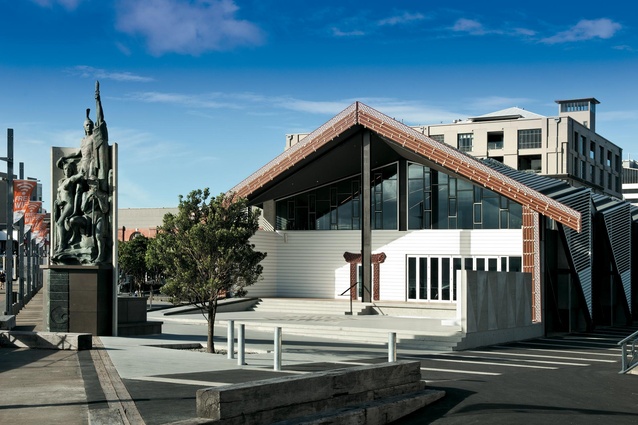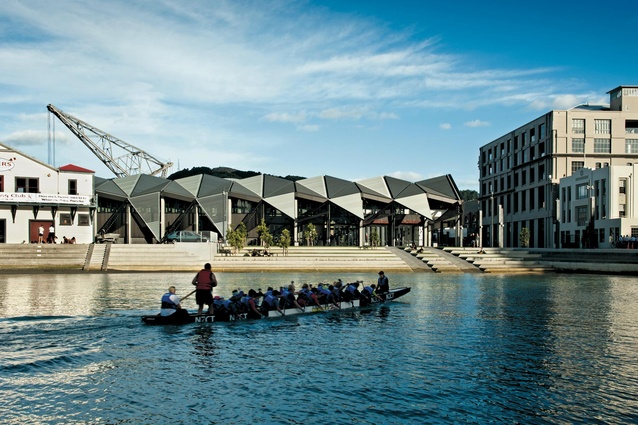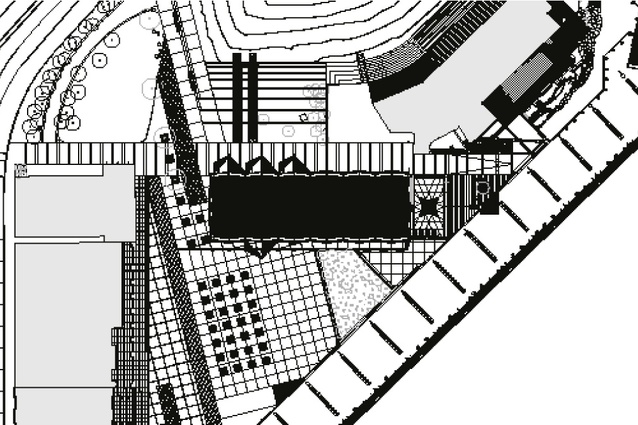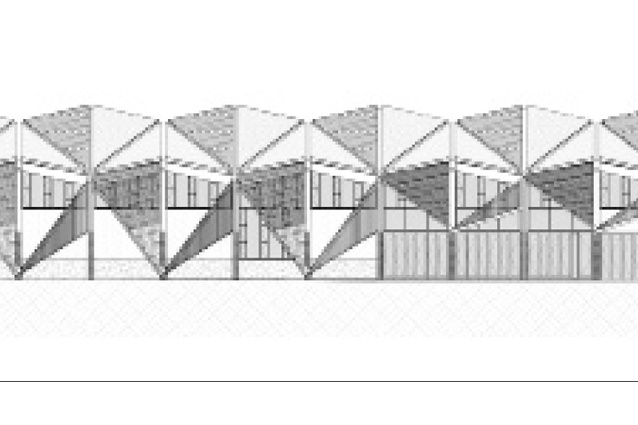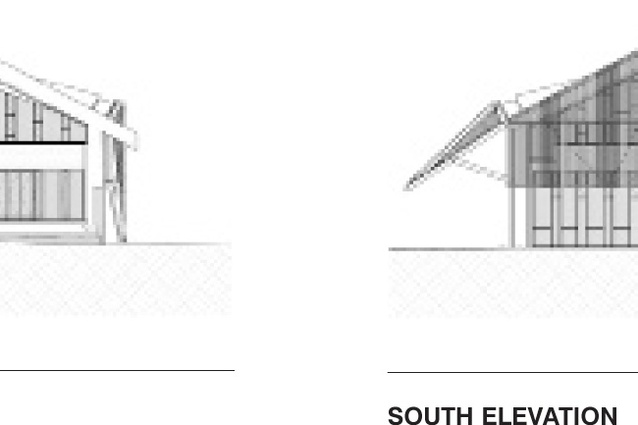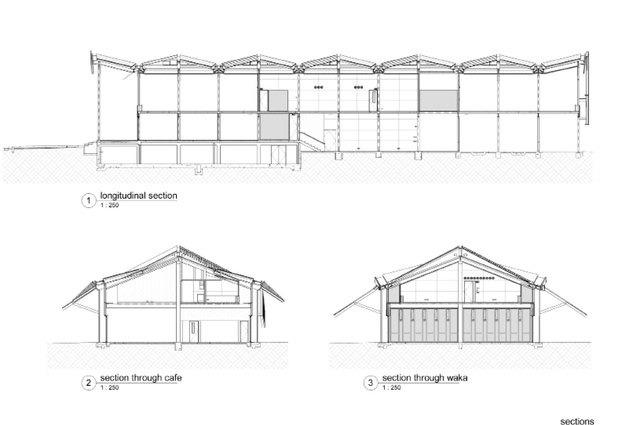Te Raukura Te Wharewaka o Poneke
Back in 1992 when New Zealand sent the exhibition Headlands to the new Museum of Contemporary Art in Sydney, controversy raged over the treatment meted out to senior artist Gordon Walters in an essay by a Maori art historian in the catalogue. Walters was renowned for his deployment of the koru, a motif derived from the shape formed as fern unfurls in the bush and found in the patterning painted on rafters in Maori meeting houses. Walters achieved success with paintings that used the koru as the basis for a thorough exploration of ambiguities in the relationship between the shape and the ground on which it was figured. His art was pure formalism, yet he stood accused of appropriation of a motif that was uniquely Maori. Like the modernists of the early 20th century, it was argued, Walters was raiding another culture’s treasure box for his own gain.
Twenty years later, appropriation of Maori motifs in art and architecture has ceased to cause such cultural anxiety. Ironically, some of the design elements in Te Raukura/Te Wharewaka o Poneke derive from patterns created by Pakeha painter Richard Killeen, one of Walters’ staunchest defenders, in the wake of this so-called appropriation debate. Inspired by tukutuku patterns and the structure of Maori items of personal adornment such as combs, Killeen developed a series of works based on the koru, chevron and triangle. They looked Maorified, but served to undermine the idea of cultural copyright, instead showing that the shapes could be found in a range of European and non-European cultures. For the roof design, Principal of architecture + Stuart Gardyne says he was inspired specifically by the Killeen comb works, where a rectangular canvas is diagonally bisected by a string of triangles. Rather than appropriation, this is a sophisticated nod to the cultural politics of yore. The triangular roof patterning weaves in a more nuanced take on the old debate, and becomes an instance of a Pakeha architect making reference to earlier work by a Pakeha artist who was provocatively reworking Maori art for his own polemical purposes.
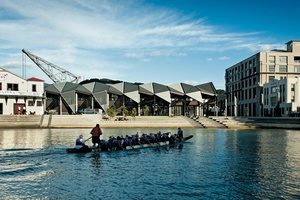
Despite cleverly sidestepping appropriation issues, the building has still been controversial. First, in 2011, a Waiwhetu-based Atiawa group led by former secretary of Maori Affairs Dr Kara Puketapu sparked court action when they refused to return the Wellington City Council ratepayer-funded waka Te Raukura. Carved by Waiwhetu-based Rangi Hetet and six helpers as part of the Treaty of Waitangi sesquicentennial commemorations in 1990, this waka originally cost $100,000. In 2004, it was rehulled in kauri (costing a further $80,000) and, to protect it, the Wellington City Council paid rent for it to be housed at Waiwhetu’s Te Maori museum in Lower Hutt. As it was this waka that the new waterfront structure had been designed to house, the wharewaka was re-christened Te Raukura when it opened – without the waka – on Waitangi Day, 6 February 2011. This renaming signified that the building had three parts: the wharewaka to house canoes, a conference centre or whare tapere and a whare kai where the café is situated. City Council deadlines to return Te Raukura have been consistently ignored and, just after the opening in February last year, the erroneous headline “Whare too small for waka” seemed to suggest that no waka would fit in the building anyway. Yet it was Te Raukura’s sister waka, Te Aniwaniwa from the Hutt Valley – a canoe that was never intended to be housed there – that was too large for the 1,800m2 new building. The underlying problem seemed to be that Waiwhetu Maori felt that housing any waka on the waterfront next to ‘Party Central’ for the 2011 Rugby World Cup crowds was disrespectful, as it was tantamount to putting the waka in amongst 1,800 drunks.
But the waka itself is just a symbol of a much larger grievance, and the dispute with Waiwhetu Maori continues. On 26 April 2012, The Dominion Post announced that the auditor-general’s office was investigating a complaint from Stokes Valley JP, former police officer and former Lower Hutt City councillor Tata Parata that the $12.5-million wharewaka was a misuse of public money. Parata argued that it was built using money from the $24.7-million Port Nicholson Block Treaty settlement, and without due process. The building was nothing more than a publicly-owned commercial catering operation, he contended, providing no benefit to Taranaki Whanui, the grouping of 14,000 settlement claimants. It is the $7.0 million worth of funding that had come from the government that Parata is contesting, as a further $1.0 million was provided by the Wellington City Council and the rest came from Wellington Tenths Trust, the Port Nicholson Block Treaty Settlement Trust, Wharewaka o Poneke Charitable Trust and the Palmerston North Maori Reserve Trust.
Despite these unresolved issues, the Wellington City Council is relieved to have finally built the wharewaka after a decade of prevarication. Here on the waterfront is a physical manifestation of the city’s commitment to mana whenua. The Taranaki Whanui – Te Atiawa, Taranaki, Ngati Ruanui, Ngati Tama and Ngati Mutunga – have an exhibition and function area with a café and commercial kitchen and office space that allows them to host powhiri and showcase carvings, built right on the site originally occupied by tipuna. Not only is there a magnificent new waka taua (Te Raukura is still AWOL) in the building, there are also waka ama, the six-person outrigger canoes used for voyaging. While it is entirely contemporary, customary concepts have governed the orientation and decoration of the wharewaka, aligning it with wharenui design. Facing north-east toward Taranaki, the iwi’s maunga, the wharewaka holds out arms to welcome visitors. Maihi or bargeboards carved by Rangi Kipa adorn Te Tau Ihu or the ‘prow of the canoe’ part of the building’s structure. Kipa is also responsible for the pare (lintels) above doorways and, eventually, there will be poupou (carved figures) inside and out. Most significantly, the building has been conceived of as being dressed like a human body in a korowai of zinc panels, which not only disguise plant and equipment such as extractor fans, but also allow the abstracted Killeen-type triangular patterning to become dominant.
As Te Papa’s current exhibition of kahu ora or living cloaks shows, the making of korowai has occasioned much innovation and they bestow great mana and prestige on wearers. Cared for as a taonga, to be passed down from the ancestors to their descendants and shared across cultures, the korowai is the perfect metonym for this new idiom of bicultural building, which is a watershed structure in more ways than one.


